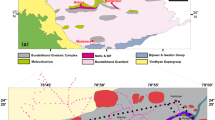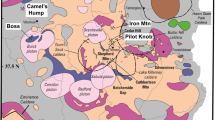Abstract
The late Archean Western Dharwar Craton supergroup has volcanic and sedimentary rocks deposited during 2900–2600 Ma underlain by the Sargur Group basement of 3.36–3.2 Ga granitic gneiss and older supracrustal rocks. The western part of the craton, known as the western province (Dharwar Foreland), comprises four major schist belts (Western Ghats-Bababudhan-Shimoga-Chitradurga). A regional gravity and magnetic (Total Field) survey was done in the Shimoga region. The geophysical data of the study area reveal the subsurface extension and behaviour of the exposed rocks of the area. The Euler deconvolution was used to define the depth of the anomaly sources. Euler depth solution for the spherical body (structural index 2), window size = 10, and depth tolerance = 5% depicts the depth of the various sources. The Euler depth solutions cluster over the hook-shaped schist rock of the Medur group (at the northern part of the area) reveals that the body's depth varies from 1 to 4 km in the central part, and at the northern flank, it goes up to 7 km. The solution also brought out the depth of the anomalous body near Hithala, within 4 km. The 2D forward depth modelling of the anomalous zone brings out the involvement of the tectonic forces in the generation of this anomalous body. The more precise depth from the model has been estimated between 2 and 3 km. The model clearly shows the relationship between schist rocks and the basement. However, the high-gravity anomaly has been modelled as the manganese bearing horizon, which has come to optimum depth because of folding and faulting in the region, thus providing a favourable zone for manganese deposition.

















Similar content being viewed by others
References
Chadwick B, Vasudev VN, Jayaram S (1988) Stratigraphy and structure of late Archaean Dharwar volcanic and sedimentary rocks and their basement in a part of the Shimoga basin, east of Bhadravathi. Karnataka J of Geol Soc India 32:1–19
Chadwick B, Vasudev VN, Ahmed N (1996) The Sandur schist belt and its adjacent plutonic rocks implications for late Archaean crustal evolution in Karnataka. J of Geol Soc India 47(1):37–57
Chinnaiah (2014) Occurrence and distribution of manganese ore types in the Shimoga area. Ind J App Sci. 5 (1) 161–169
Geological Survey of India (2006) Geology and Mineral resources of states of India Part –VII Karnataka & Goa. Miscellaneous Publication No. 30.
Geological Survey of India (2016) Scale 1:250,000 Geological Quadrangle Map (Second Edition) of Ranibennur Quadrangle
Geological Survey of India (2018) 1:50,000 Geological Map Series Toposheet 47N/08
Ghosh GK (2015) Interpretation of gravity data and using 3D Euler deconvolution tilt angle and horizontal tilt angle source edge approximation of the North-West Himalaya. Acta Geophys. https://doi.org/10.1515/acgeo-2016-0042
Gokarn SG, Gupta G, Rao C (2004) Geoelectric Structure of The Dharwar Craton from magnetotelluric studies; Archean suture identified along the Chitragurga-Gadag schist belt. Geophy J Int 158(2):712–728
Gokarn SG, Rao CK, Gupta G (1998) MT studies over the Dharwar craton, 35th Annual convention and meeting on evolution of continental margins. Process and Potential pp 51–52.
Harinadha Babu P, Ponnuswamy M, Krishnamurthy KV (1981) Shimoga belt in early Precambrian supracrustals of southern Karnataka. J Geol Soc India Memoir 112:199–218
Jacobsen BH (1987) A case for upward continuation as a standard separation filter for potential field maps. Geophysics 52:1138–1148
Kaila KL, Bhatia SC (1981) Gravity study along the Kavali-Udipi deep seismic sounding profile in the Indian Peninsular Shield: some inferences about the origin of Auothosites and the Eastern Ghats orogeny, Tectonophysics. J Geol Soc India 79:129–143
Miller HG, Singh V (1994) Potential feld tilt a new concept for location of potential feld sources. J App Geophys 32:213–217
Nabighian MN (1972) The analytic signal of two-dimensional magnetic bodies with polygonal cross-section: Its properties and use for automated anomaly interpretation. Geophysics 37:507–717
Narayan S, Kumar U, Pal SK, Sahoo SD (2021) New insights into the structural and tectonic settings of the Bay of Bengal using high-resolution earth gravity model data. Acta Geophys 69:2011–2033
Pal SK, Narayan S, Majumdar TJ, Kumar U (2016) Structural mapping over the 85°E Ridge surroundings using EIGEN6C4 high-resolution global combined gravity field model: an integrated approach. Mar Geophys Res. https://doi.org/10.1007/s11001-016-9274-3
Qureshy MN, Aravamadhu PS, Bhatia SC (1967) Some regional gravity traverses through India. Proc Symp UMP Hyderabad pp 120–133
Radhakrishna BP, Naqv SM (1986) Precambrian continental crust of India and its evolution. J of Geol 94:145–166
Radhakrishna BP, Vaidyanadhan R (1994) Geology of Karnataka; Geol. Soc. India Bangalore, pp 298
Ramadas G, Bhagya K (2016) Tectonic classification of Dharwar Craton, India based on the inversion of regional Bouguer gravity. Int J of Adv Res. Doi:https://doi.org/10.21474/IJAR01/1480
Rao VV, Danodara N, Sain K, Sen MK, Murty ASN, Sarkar D (2015) Upper crust of the Archean Dharwar Craton in southern India as revealed by seismic refraction tomography and its geotectonic implications. Geophys J Int 200:652–663
Reid AB, Allsop JM, Granser H, Millett AT, Somerton IW (1990) Magnetic interpretation in three dimensions using Euler deconvolution. Geophysics 55(1):80–90
Roest WR, Jacob Verhoef S, Pilkington M (1992) Magnetic interpretation using the 3-D analytic signal. Geophysics 57(1):116–125
Singh AP, Mishra DC, Gupta SB, Rao MRKP (2004) Crustal structure and domain tectonics of the Dharwar Craton (India): insight from new gravity data. J of Asian Earth Sci Vol.23
Spector A, Grant FS (1970) Statistical models for interpreting aeromagnetic data. Geophysics 35:293
Srinivasan R, Naha K (1993) Archaean sedimentation in the Dharwar craton, southern India. Proc Natl Acad Sci India 63A:1–13
Subrahmanyam C, Verma RK (1981) Densities and magnetic susceptibilities of Precambrian rocks of different metamorphic grade (Southern Indian shield). J Geophys 49:101–107
Subrahmanyam C, Verma RK (1982) Gravity interpretation of the Dharwar greenstone- gneiss-granite terrain in the southern Indian shield and its geological implications. Tectonophysics 84:225–245
Swami Nath J, Ramakrishnan M (1981) Early Precambrian Supracrustals of Southern India. Memoirs of the Geol Surv of India 112:350
Thompson DT (1982) EULDEPTH- A new technique for making computer-assisted depth estimation from magnetic data. Geophysics 47:31–37
Acknowledgements
The authors are very grateful to the Editorial Team, Acta Geophysica. The corresponding author wishes to place on record great appreciation to all the geophysicists, geophysical logging team and geologist of GSI, southern region, who were engaged in data generation and have conscientiously collected this valuable data under NGPM, geophysical logging and geological mapping, respectively. The authors also thank Dr. Biplab Chakraborty, Director, GSITI, and Mr. B. Ravi, Sr. Geophysicist, for his support and technical advice. The authors also express thanks to Miss Nimmy Chandran, Sr. Geologist, Miss. Hima Raghunath, Sr. Geologist, and Mr. Jitender Kumar, Geologist, GSI, Bangalore, for their help identifying rock samples.
Author information
Authors and Affiliations
Corresponding author
Ethics declarations
Conflict of interest
The corresponding author states that there is no known conflict of interest.
Additional information
Edited by Prof. Ivana Vasiljevic (ASSOCIATE EDITOR) / Prof. Gabriela Fernández Viejo (CO-EDITOR-IN-CHIEF).
Rights and permissions
Springer Nature or its licensor (e.g. a society or other partner) holds exclusive rights to this article under a publishing agreement with the author(s) or other rightsholder(s); author self-archiving of the accepted manuscript version of this article is solely governed by the terms of such publishing agreement and applicable law.
About this article
Cite this article
Das, N., Bhattacharya, S.K., Narayan, S. et al. Identifying the tectonically induced mineralisation zone in the central part of Dharwar-Shimoga greenstone belt, Western Dharwar Craton: an integrated analysis of gravity and magnetic data. Acta Geophys. 72, 1731–1748 (2024). https://doi.org/10.1007/s11600-023-01181-7
Received:
Accepted:
Published:
Issue Date:
DOI: https://doi.org/10.1007/s11600-023-01181-7




